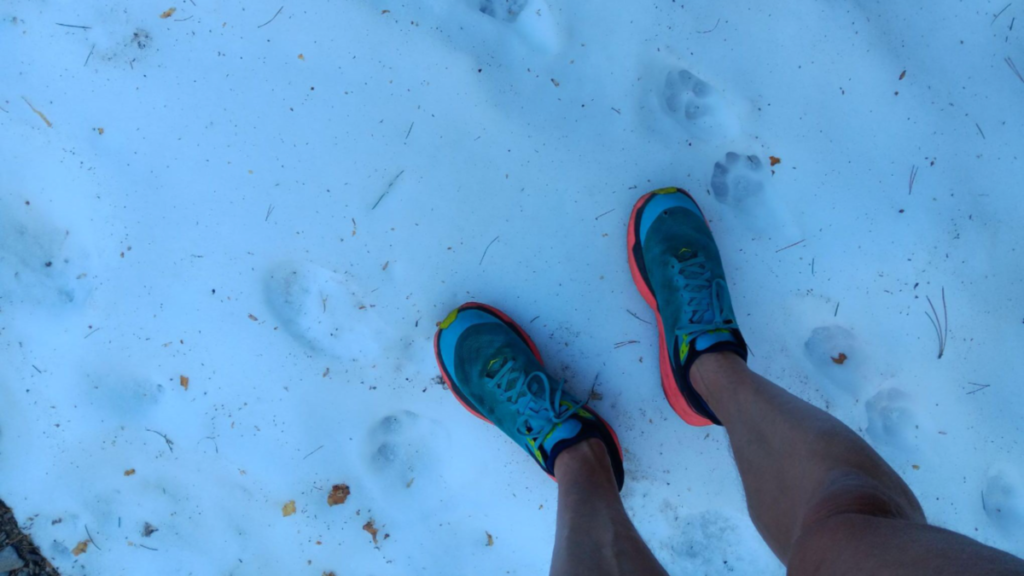
I love trail running in the springtime. Being out in nature as the world awakens from a winter slumber seems to refresh my soul. The side effect of that is that I tend to overdo things by trying to run too far right at the start of spring.
Temperature plays a crucial role in performance during spring trail runs. In colder weather, our bodies need to work harder to maintain warmth, potentially leading to increased energy expenditure. Running in hot temperatures results in quicker dehydration affecting overall performance.
Let’s take a closer look at all the ways to get the most out of our springtime trail running.
The Science of Spring Trail Running: How Weather Impacts Performance
How does temperature affect trail running performance, and what strategies can runners employ to optimize performance in varying temperatures?
Temperature plays a crucial role in determining a trail runner’s performance during spring runs. In colder temperatures, the body needs to work harder to maintain warmth, potentially leading to increased energy expenditure. On the other hand, running in hot temperatures can result in quicker dehydration and higher heart rates, affecting overall performance.
To optimize performance in varying temperatures, runners can employ several strategies. In colder weather, wearing layers that can be easily removed as the body warms up is essential. Additionally, staying hydrated and fueling properly before and during the run can help maintain energy levels. In hot temperatures, wearing breathable and moisture-wicking clothing, as well as carrying water or electrolyte drinks, is crucial to prevent dehydration and overheating.
By understanding how temperature impacts the body and implementing appropriate strategies, trail runners can adapt to varying weather conditions and optimize their performance on spring trails.
Understanding Humidity’s Role in Trail Running Performance
Humidity levels play a significant role in impacting runners’ physiological responses and energy expenditure during spring trail runs. High humidity can make it challenging for the body to regulate temperature efficiently, leading to increased sweating and potential dehydration. As a result, runners may experience higher perceived exertion levels and decreased performance due to the added strain on the cardiovascular system.

In contrast, low humidity levels can also have implications for trail runners. Dry air can lead to increased respiratory effort as the body works harder to humidify the air during breathing. This can result in quicker dehydration and potential discomfort while running.
Understanding how humidity influences the body’s responses is crucial for trail runners looking to optimize their performance. Strategies such as adjusting pace and effort levels based on humidity levels, staying well-hydrated before and during runs, and wearing moisture-wicking clothing can help mitigate the effects of humidity on performance.
By being aware of how humidity impacts their bodies and implementing appropriate strategies, trail runners can adapt to varying humidity levels and enhance their performance on spring trails.
Altitude Adaptation: Navigating High Elevations on Spring Trails
Altitude can significantly impact trail running performance, especially during springtime when runners may encounter higher elevations. The decrease in oxygen levels at higher altitudes can lead to decreased aerobic capacity, making it more challenging to maintain pace and endurance. To navigate high elevations effectively, trail runners can implement strategies for acclimatization.
One key tip for acclimatizing to higher elevations is gradual exposure. By slowly increasing the elevation of runs over time, runners give their bodies the opportunity to adapt to the lower oxygen levels. This gradual approach can help minimize the negative effects of altitude on performance and reduce the risk of altitude sickness.
Additionally, staying well-hydrated and properly fueled is essential for supporting the body’s adaptation to higher elevations. Adequate hydration and nutrition can help maintain energy levels and aid in the acclimatization process.
By understanding the effects of altitude on trail running performance and implementing acclimatization strategies, runners can better navigate high elevations during springtime runs and optimize their overall performance.
Temperature Regulation Techniques for Spring Trail Runs
To optimize performance during spring trail running, it is crucial to implement effective temperature regulation techniques. One key aspect to consider is proper clothing choice. Opt for moisture-wicking fabrics that can help regulate body temperature by keeping sweat away from the skin, preventing overheating or chilling. Layering is also essential, allowing you to adjust your clothing as temperatures fluctuate during the run.
Hydration plays a significant role in temperature regulation as well. Maintaining proper fluid intake helps the body regulate temperature through sweat evaporation. Electrolyte-rich drinks can aid in hydration and prevent overheating or dehydration, especially in warmer spring conditions.
Another technique to manage body temperature is to adjust your pace according to the weather. In hotter temperatures, consider slowing down to prevent overheating and conserve energy. Conversely, in cooler conditions, maintaining a steady pace can help generate body heat and prevent chilling.
By incorporating these temperature regulation strategies into your spring trail runs, you can enhance your performance, stay comfortable, and reduce the risk of temperature-related issues.
Hydration Strategies: Balancing Fluid Intake with Springtime Conditions
To optimize performance during spring trail running, it is crucial to prioritize hydration strategies that align with the changing springtime conditions. Proper hydration plays a vital role in supporting trail runners’ performance and overall well-being.
When navigating spring trails, it’s essential to balance fluid intake effectively. Hydration needs can vary depending on factors such as temperature, humidity, and the intensity of the run. To maintain optimal performance, trail runners should aim to drink fluids regularly before, during, and after their runs.
Electrolyte-rich drinks can be particularly beneficial in spring conditions, helping to replenish essential minerals lost through sweat and supporting hydration levels. Additionally, considering the duration and intensity of the run can guide the amount of fluids needed to stay properly hydrated.
By understanding the importance of proper hydration and implementing effective fluid intake strategies, trail runners can enhance their performance, prevent dehydration, and maintain their energy levels throughout their springtime runs.
Impact of Wind on Spring Trail Running Efficiency
When tackling spring trail running, it’s crucial to consider how wind conditions can impact your efficiency on the trails. Wind plays a significant role in affecting a runner’s performance, especially when facing strong gusts or headwinds.

Running against the wind can increase the effort required, potentially slowing down your pace and leading to fatigue more quickly. On the other hand, running with a tailwind can provide a slight boost in speed but may also impact your running form and stability.
To mitigate the effects of wind on your spring trail runs, consider adjusting your running technique to minimize resistance. Tucking in behind other runners or trees can provide some shelter from strong winds. Additionally, wearing appropriate gear like wind-resistant clothing can help reduce the impact of wind chill and maintain your body temperature.
By being mindful of wind conditions and implementing strategic adjustments, such as pacing yourself against headwinds and utilizing tailwinds to your advantage, you can optimize your running efficiency and performance on spring trails.
The Role of Sun Exposure in Spring Trail Running Performance
When hitting the trails in spring, the role of sun exposure cannot be underestimated in influencing a trail runner’s performance. Sun exposure can affect runners in various ways, from increasing the risk of sunburn and heat exhaustion to impacting overall performance and endurance.
To optimize performance and ensure safety, trail runners must implement effective sun protection strategies. This includes wearing appropriate sun-protective clothing, such as UV-resistant shirts and hats, and applying sunscreen with a high SPF to exposed skin areas. Additionally, considering the timing of your runs to avoid peak sun hours can help minimize sun exposure and reduce the risk of overheating.
Heat management is also crucial when dealing with sun exposure during spring trail runs. Staying hydrated by carrying an adequate supply of water or sports drinks is essential to prevent dehydration and maintain performance levels. Moreover, incorporating cooling techniques like wetting your clothing or using cooling towels can help regulate body temperature and enhance comfort during runs in sunny conditions.
By being proactive in addressing sun exposure and heat management, trail runners can safeguard their performance and well-being on spring trails.
Weather Forecasting: Utilizing Information for Optimal Performance
Understanding weather forecasts is crucial for trail runners looking to optimize their performance on spring trails. By staying informed about upcoming weather conditions, runners can make informed decisions about their training sessions and races.
One key tip for trail runners is to pay attention to not only the predicted temperature but also factors like humidity, wind speed, and precipitation chances. This information can help runners adjust their clothing, hydration strategies, and pacing to suit the expected conditions. For example, knowing that a hot and humid day is forecasted can prompt a runner to carry extra water and plan for more frequent hydration stops.
Interpreting weather forecasts can also aid in planning the timing of runs. Avoiding extreme weather conditions like thunderstorms or excessive heat can help prevent potential risks and ensure a more comfortable and efficient running experience. By utilizing weather information effectively, trail runners can adapt their training sessions to the conditions, ultimately leading to better performance outcomes.
Psychological Considerations: Spring Weather’s Effect on Mental Stamina
Spring weather conditions can significantly impact runners’ mental stamina and motivation during trail running. The unpredictability of spring weather, such as sudden changes in temperature, unexpected rain showers, or strong winds, can pose challenges to a runner’s mindset. To maintain focus and mental resilience in the face of these conditions, it is essential for trail runners to employ specific techniques.
One effective strategy is to practice mindfulness and stay present in the moment while running. By focusing on the sensations of the body, the rhythm of breathing, and the surrounding nature, runners can cultivate a sense of calm and concentration, even in adverse weather conditions. Additionally, setting realistic goals and breaking down the run into smaller, manageable segments can help maintain motivation and prevent feelings of overwhelm.
Moreover, visualizing success and positive outcomes before a run can boost confidence and mental strength. Creating a mental image of overcoming challenges and finishing strong can provide the necessary motivation to push through difficult weather conditions. By incorporating these psychological techniques into their training routine, trail runners can enhance their mental stamina and performance on spring trails.
Nutritional Needs for Spring Trail Running: Fueling Amidst Changing Weather
To optimize performance and endurance in spring trail running, trail runners must pay close attention to their nutritional needs amidst changing weather conditions. As the temperatures fluctuate and humidity levels vary, it is crucial to adjust dietary intake accordingly to support energy levels and overall performance.

Hydration plays a vital role in maintaining peak performance on spring trails, especially as the weather warms up. Electrolyte-rich drinks can help replenish essential minerals lost through sweat, while water intake should be consistent to prevent dehydration. Additionally, incorporating carbohydrate-rich snacks like energy gels or bars can provide a quick energy boost during longer runs.
Furthermore, considering the impact of temperature on appetite, trail runners may need to adapt their eating patterns to ensure adequate fueling. Foods that are easily digestible and rich in nutrients, such as fruits, nuts, and lean proteins, can help sustain energy levels throughout a run. By understanding the nutritional demands of spring trail running and making appropriate adjustments to their diet, runners can optimize their performance and enjoy a successful and fulfilling trail running experience.
Recovery Strategies: Post-Run Care in Variable Spring Conditions
Transition: After completing a challenging spring trail run, it’s crucial to prioritize recovery to support your body’s adaptation to variable weather conditions.
To effectively recover from your trail run in changing spring weather, rest plays a vital role in allowing your muscles to repair and rebuild. Adequate sleep and relaxation are essential for recovery, helping to reduce fatigue and prevent overtraining. Additionally, incorporating proper nutrition post-run is key to replenishing energy stores and supporting muscle recovery. Consuming a balanced meal or snack with a mix of carbohydrates and proteins can aid in this process.
Injury prevention is also paramount in maintaining a consistent trail running routine during the unpredictable spring weather. Implementing stretching exercises, foam rolling, and cross-training activities can help prevent injuries and improve overall performance. Listening to your body and addressing any discomfort promptly can prevent minor issues from escalating.
By incorporating these recovery strategies into your post-run routine, you can enhance your performance, reduce the risk of injuries, and ensure a more enjoyable and sustainable trail running experience in variable spring conditions.
Environmental Conservation: Responsible Practices for Spring Trail Running
Transitioning from focusing on personal performance to broader environmental considerations, trail runners must prioritize environmental conservation during their springtime outings. “Environmental stewardship” and “responsible practices” are not just buzzwords but essential principles to uphold while enjoying the trails.
One crucial aspect of responsible trail running is minimizing the impact on natural ecosystems. This involves staying on designated trails to prevent soil erosion, protecting fragile vegetation, and respecting wildlife habitats. Additionally, proper waste management, such as carrying out all trash and waste, is vital to preserve the pristine beauty of the trails for future generations.
Moreover, being mindful of the Leave No Trace principles, which emphasize leaving nature as you found it, is key to sustainable trail running. Simple actions like avoiding disturbing wildlife, refraining from picking plants, and minimizing noise pollution can significantly contribute to environmental conservation efforts.
By embracing these responsible practices and fostering a culture of environmental stewardship within the trail running community, runners can enjoy the beauty of springtime trails while ensuring the preservation of these natural spaces for years to come.
